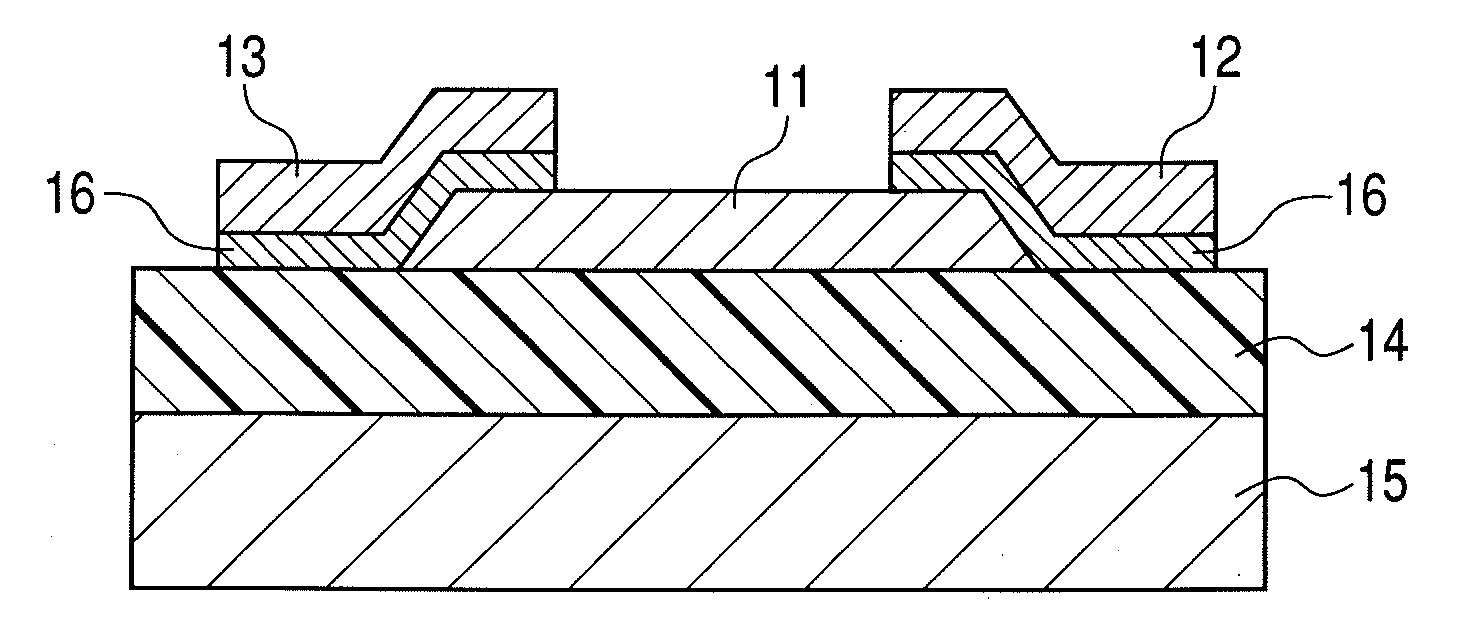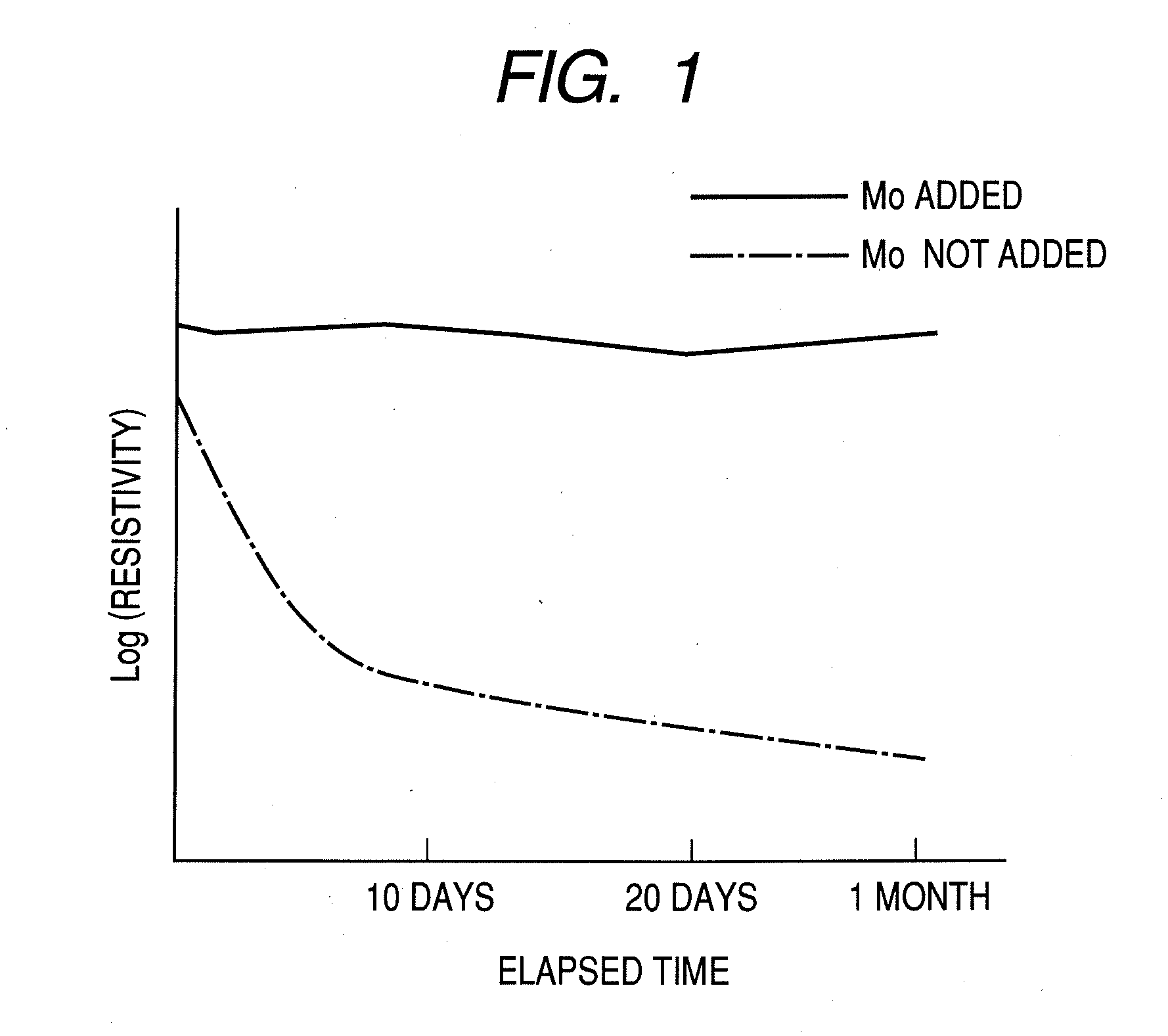Amorphous oxide and field effect transistor
a field effect transistor and oxide technology, applied in the direction of basic electric elements, electrical equipment, semiconductor devices, etc., can solve the problems of variable tft characteristics, and achieve excellent field-effect mobility, excellent transistor characteristics, and excellent s value
- Summary
- Abstract
- Description
- Claims
- Application Information
AI Technical Summary
Benefits of technology
Problems solved by technology
Method used
Image
Examples
example 1
(Comparative Evaluation of Example 1 and Comparative Examples 1 and 2)
[0086]With regard to the In—Zn—O active layer with Mo added thereto obtained in Example 1, the optical absorption spectrum was analyzed. Band gap of the above-mentioned oxide film with Mo added thereto was about 2.7 to 2.9 eV depending on the atomic composition ratio of In, which is substantially the same as those of the In—Zn—O film of Comparative Example 1 and the In—Zn—O film with Mo added thereto of Comparative Example 2.
[0087]Next, in order to review the stability over time of the In—Zn—O film with Mo added, the oxide films manufactured in Example 1 and Comparative Examples 1 and 2 were left at rest in an atmosphere at a temperature of 20° C. and at a humidity of 50%, and the variations over time of the resistivity were measured. With regard to the oxide films of Comparative Examples 1 and 2, after being left at rest for a month, the resistivity decreased substantially by an order to two orders of magnitude d...
example 2
[0094]A second example of a TFT device according to the present invention is now described with reference to FIG. 4. In this example, an In—Zn—Ga—O film was used as the active layer.
[0095]In this example, Mo was used as the gate electrode 15 and a silicon oxide film at a thickness of about 150 nm was used as the gate insulating film 14. The substrate was a glass substrate, and the In—Zn—Ga—O film with Mo added thereto was formed on the glass substrate as the active layer 11.
[0096]The In—Zn—Ga—O film was formed using a co-sputtering apparatus with diagonal incidence configuration. In this example, there were three elements of In2O3, ZnO, and Ga2O3 in forming the film, and hence an In—Zn—Ga—O thin film having a Ga atomic composition ratio distribution of 1 atom % or higher and 10 atom % or lower in one substrate surface could be obtained. Further, here, a Ga concentration distribution was formed in a direction orthogonal to the composition slope of In—Zn.
[0097]As the target (material ...
example 3
[0114]A TFT device having the same structure as that of the above-mentioned Example 2 except for the electrodes was manufactured. In this example, an Mo electrode at a thickness of about 100 nm formed by an electron beam deposition method was used as the gate electrode 15, the source electrode 12, and the drain electrode 13.
[0115]In this example, the most satisfactory transistor characteristics were obtained when the atomic composition ratio of Ga, Ga / (In +Ga+Zn), was 1 atom % and when the atomic composition ratio of In expressed as In / (Zn+In) was about 30 to 80 atom %. In the range of the above-mentioned composition, independently of the atomic composition ratios of the metals, substantially similar characteristics were obtained. For example, the on-current Id was, when Vg=10 V, about 4×10−4 A, which was a larger value compared with the TFT in Example 2 in which the In—Zn—Ga—O film with Mo added thereto was used as the active layer. The reason is thought to be that, in this example...
PUM
 Login to View More
Login to View More Abstract
Description
Claims
Application Information
 Login to View More
Login to View More - R&D
- Intellectual Property
- Life Sciences
- Materials
- Tech Scout
- Unparalleled Data Quality
- Higher Quality Content
- 60% Fewer Hallucinations
Browse by: Latest US Patents, China's latest patents, Technical Efficacy Thesaurus, Application Domain, Technology Topic, Popular Technical Reports.
© 2025 PatSnap. All rights reserved.Legal|Privacy policy|Modern Slavery Act Transparency Statement|Sitemap|About US| Contact US: help@patsnap.com



